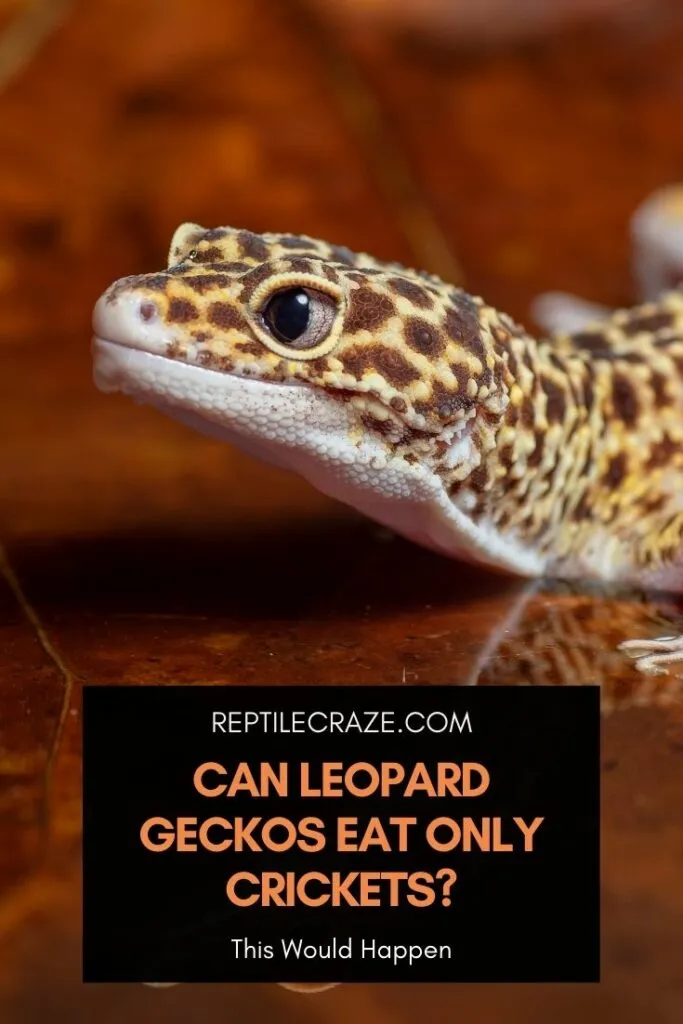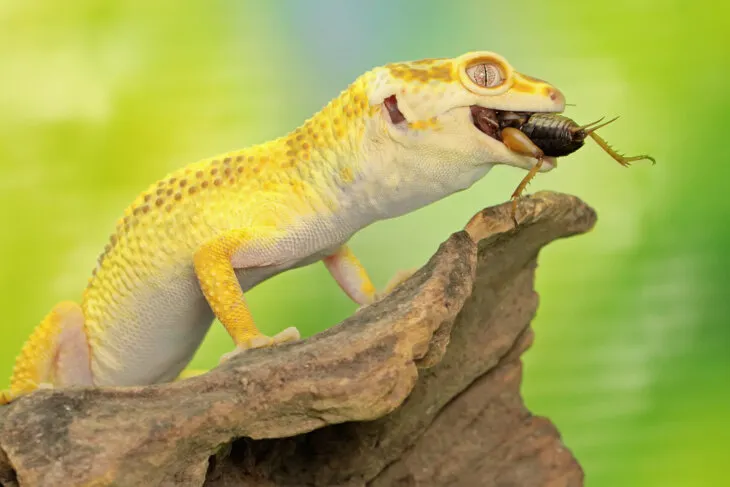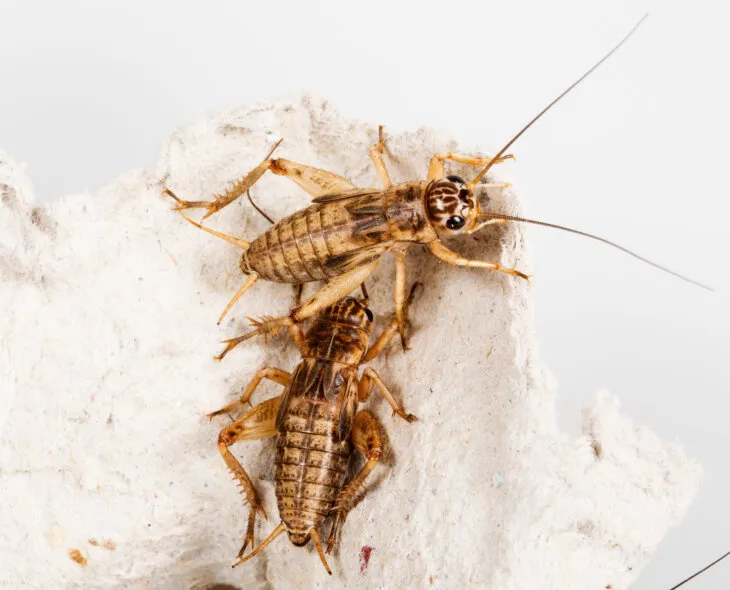
If you only have one Leopard Gecko (Eublepharis macularius), your pet may not be able to eat multiple containers of feeders before the insects grow, change, or die. This problem leads to owners feeding only one type of insect at a time, in order to avoid wastage. But, can Leopard Geckos eat only crickets (Acheta domesticus)?
Leopard Geckos should be fed a varied diet that can be adapted to meet their nutritional needs over the course of their life. Crickets are high in protein, but low in fat, and have a poor Ca:P ratio. The Ca:P ratio can be corrected with gut loading, to make crickets an appropriate low-fat diet.
That’s the quick answer, but read on to discover the best way to meet your Leopard Gecko’s nutritional needs.
Table of Contents
What Would Happen If A Leopard Gecko Ate Only Crickets?
If a Leopard Gecko ate only crickets, with no supplementation or variation, he may become underweight, and would eventually suffer from metabolic bone disease.
Leopard Gecko Would Become Underweight
An underweight Leopard Gecko will have a slim tail. The tail should not be thinner than the width of the neck. Also, the curves of the Leopard Gecko’s body would become concave (scooped in) as opposed to convex (curved outward).
An adult Leopard Gecko that weighs under 40 grams would be considered underweight. They will also be lethargic, and may struggle to hunt lively prey. They need to eat more calorific foods such as mealworms and BSF larvae.
Leopard Gecko Would Get Metabolic Bone Disease
Metabolic bone disease occurs when Leopard Geckos do not get enough calcium, or they get too much phosphorus in the diet.
Other causes include lack of vitamin D, which is essential for the absorption of dietary calcium, and lack of UV light available.
Calcium is the most abundant mineral in the body. It is responsible for nerve transmission, blood clotting, muscle contractions, and skeletal strength.
The ideal dietary calcium to phosphorus ratio for Leopard Geckos is 1:1 to 2:1. Crickets provide a Ca:P ratio of 1:9. This means they provide far more phosphorus than they do calcium.
The result is that the phosphorus will bind and remove too much calcium from the bloodstream, leaving not enough for the Leopard Gecko’s organs to function.
Therefore, the geckos’ body will draw calcium from its bones. This will eventually cause deformity, seizures, and death.

Nutritional Information For Crickets Vs Other Feeder Insects
Compared to other popular feeder insects, crickets surprisingly contain the most moisture. Their protein level is comparable with mealworms and black soldier fly larvae.
However, they are lower in fat than mealworms, which is ideal if your Leopard Gecko is overweight.
Crickets are very low in fiber compared to black soldier fly larvae, which makes them unlikely to cause impaction. Find out more about why we think Leopard Geckos can and should eat crickets in our in-depth article.
| Crickets | Meal Worms | Dubia Roaches | Black Soldier Fly Larvae | Wax Worms | |
| Moisture | 73% | 66% | 65% | 64% | 62% |
| Protein | 18% | 18% | 21% | 17% | 14% |
| Fat | 6% | 10% | 9% | 11% | 18% |
| Fiber | 2% | 2% | 1% | 6% | 3% |
| Ca:P Ratio | 1:9 | 1:7 | 1:3 | 2.5:1* | 1:7 |
(BSF Larvae Ca:P ratio: Boykin et al., 2020)
*Research is ongoing as to whether the Ca:P ratio of BSF Larvae is absorbable, as most of the calcium is located in their indigestible exoskeletons.
Are There Better Insects To Feed To Leopard Geckos?
Research shows that young Leopard Geckos that are fed only mealworms grow faster and larger than Leopard Geckos fed only crickets.
Mealworms have a similar nutritional profile to crickets, except that they contain more fat and more indigestible fiber.
The findings of the research indicate that during phases when Leopard Geckos need more calories, for example when growing, or recovering from illness, then mealworms could be a better choice.
Black soldier fly larvae could be better again, given their impressive nutritional profile.
Some research suggests that BSF Larvae may provide an ideal calcium to phosphorus ratio naturally, while also being almost as high in protein and fat as mealworms.
Dubia roaches are an exceptionally popular staple feeder insect, thanks to how easy they are to keep and feed, as well as their strong nutritional profile. They contain an incredible amount of protein.
But the truth is, that to get the best nutritional aspects from every feeder insect, you need to feed your Leopard Gecko a varied diet (read our diet guide here).
Also, the nutritional needs of your Leopard Gecko change throughout their life, and depend on their current health condition.
Can Gut-Loaded Crickets Be A Complete Diet?
Research shows that gut-loading crickets effectively can alter their calcium to phosphorus ratio significantly enough to make them meet the requirements of insectivores.
In the experiment, crickets were fed a range of calcium-fortified dry diets for 48 hours before being frozen and analyzed.
The crickets were offered a range of scientifically-formulated experimental diets, plus a range of commercially available diets sold for gut-loading crickets.
Of the commercial diets tested, only one contained a sufficient amount of calcium as advertised: T-Rex® Calcium Plus
The other 3 commercial diets tested resulted in crickets that had no higher calcium level than the control group of crickets who were not fed calcium.
This research indicates that properly gut-loading crickets can transform them into a whole

Can Calcium-Dusted Crickets Be A Complete Diet?
Dusting crickets and other feeder insects with calcium-fortified vitamin powders is essential. The supplements help to raise calcium levels and improve the calcium to phosphorus ratio of the insect.
This helps avoid the contraction of metabolic bone disease.
But, dusting crickets is not without its drawbacks. For example, if the Leopard Gecko does not eat the cricket right away, the cricket will likely remove the supplement powder from its body via grooming.
Also, dusting with calcium supplementation can cause neutralization of the stomach acid. Therefore, the supplement can hinder the effective digestion of the insect.
Because of this, it may not be advisable to dust every meal with calcium, though there are many differing opinions out there.
A good recommendation is to dust crickets with calcium for 2 out of 3 weekly meals. Always consult the instructions on the calcium supplement that you have bought.
Some calcium supplements contain the essential vitamin D3, and some do not. It is possible to over-supplement vitamin D3.
In conclusion, dusted crickets do not make them ideal as the only
A Recommended Diet For Leopard Geckos
In conclusion, it is possible to feed your Leopard Gecko on only crickets, if you gut-load them extremely well using a proven formula. You also need to dust them with calcium.
However, even if you do this, you may find that your Leopard Gecko loses weight or their growth is stunted due to the lower fat content of crickets.
The nutritional needs of your Leopard Gecko change over time. Sometimes a low-fat diet will be necessary, sometimes it will be a drawback.
We recommend that if your Leopard Gecko is at a stable or appropriate weight and size, then the best diet for them is a varied one. Here is an example diet for an adult Leopard Gecko eating primarily crickets.
| Monday | 5-6 large crickets | 2-3 black soldier fly larvae |
| Wednesday | 5-6 large crickets (dusted) | 2 wax worms (every other week) |
| Saturday | 5-6 large crickets (dusted) | 2-3 black soldier fly larvae |
This diet uses crickets to provide low-fat, high-protein staple
Remember, though, that you can try different diets over time. Find out what works well, by frequently recording the size and weight of your Leopard Gecko and keeping a
- Enchi Ball Python: A Unique and Stunning Morph of Python regius - March 27, 2025
- Emerald Tree Monitor: The Enigmatic Green Guardian of the Rainforest - March 26, 2025
- The Egyptian Cobra (Naja haje): A Fascinating Serpent - March 25, 2025
